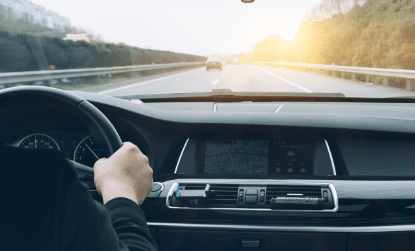The average driver typically takes one-half to three-quarters of a second to recognize the need to hit the brakes. Then it would take them another three-quarters of a second to apply the brakes. Naturally, reaction times differ from one driver to the next; nevertheless, you generally have up to a full one-and-a-half seconds between the moment you first realize you need to apply the brakes and the moment you start to slow down. You still need to come to a full stop.
Your total stopping distance may or may not be enough to keep you out of trouble.
What is total stopping distance?
Total stopping distance is the distance your vehicle travels from the moment you perceive a hazard and apply the brakes until the vehicle comes to a full stop.
Total stopping distance has two main components: braking distance and reaction distance.
Braking distance
Braking distance is the distance your vehicle will travel from the moment when you fully apply its brakes to the moment when it comes to a complete stop.
Reaction distance
Reaction distance is the distance you travel from the point when you detect a hazard until you start braking.
What are the factors that affect stopping distance?
Your total stopping distance is affected by the same factors that influence your braking distance.
These are the 7 factors you should be aware of:
1. Your speed
The speed at which your vehicle is moving is inversely proportional to your total stopping distance. The faster you’re going, the longer it takes for you to come to a full stop.
2. Condition of the road and the weather
Rain, snow, ice, mud, potholes, etc., will influence the speed at which you’re traveling and the time it will take for you to react and stop. With rain, snow, or ice, you often have to deal with poor traction.
Apart from traction, you will also have to deal with visibility in inclement weather.
All in all, weather influences road conditions. Overall, it means you will need a greater total stopping distance—particularly a longer time for your car to come to a complete stop after you’ve applied the brakes.
3. Your condition on any given day that you’re behind the wheel
Although you’re not exactly drunk or otherwise indisposed, you may not always be a hundred percent alert when driving. This is one of the reasons why accidents happen—when drivers are not as alert as they should be.
4. Your skills and experience as a driver
Your skills and experience can mean the difference between avoiding a hazard that appears out of the blue and failing to do so. Skills also factor into our level of awareness. Experienced drivers do their best to avoid getting distracted, and know that it’s better to pull over and stop if they are distracted and need to deal with the distraction (e.g., a phone call).
5. The weight of the load in your car
Driving with a heavier load means it will take you longer to come to a full stop, from the moment you perceive a hazard to the moment you apply the brakes to the moment you finally completely stop.
6. The age/condition of your car
An old car doesn’t necessarily mean a greater total stopping distance. How you take care of your vehicle can influence the way your car performs on the road.
7. Your braking system
Having well-maintained brakes helps reduce your stopping distance. It’s even better if you have ABS (anti-lock braking system).
Situational awareness behind the wheel plays a huge part in helping you avoid accidents and unnecessary expenses from of costly repairs. Being mindful can give you all the vital seconds you need to come to a stop at a safe distance from the hazard you need to avoid.
To help with future repairs when you’re no longer covered by your manufacturer’s warranty, check out EverCare’s products and services for great savings opportunities.

